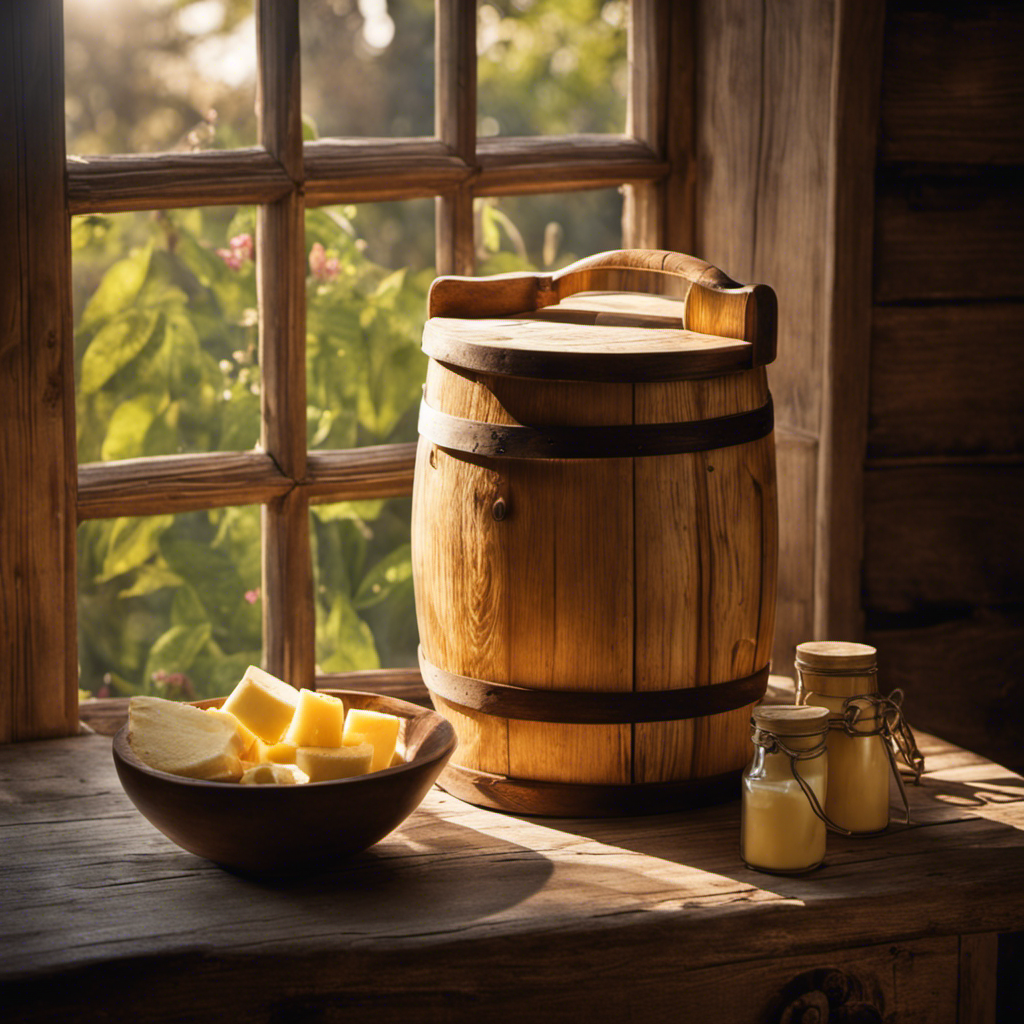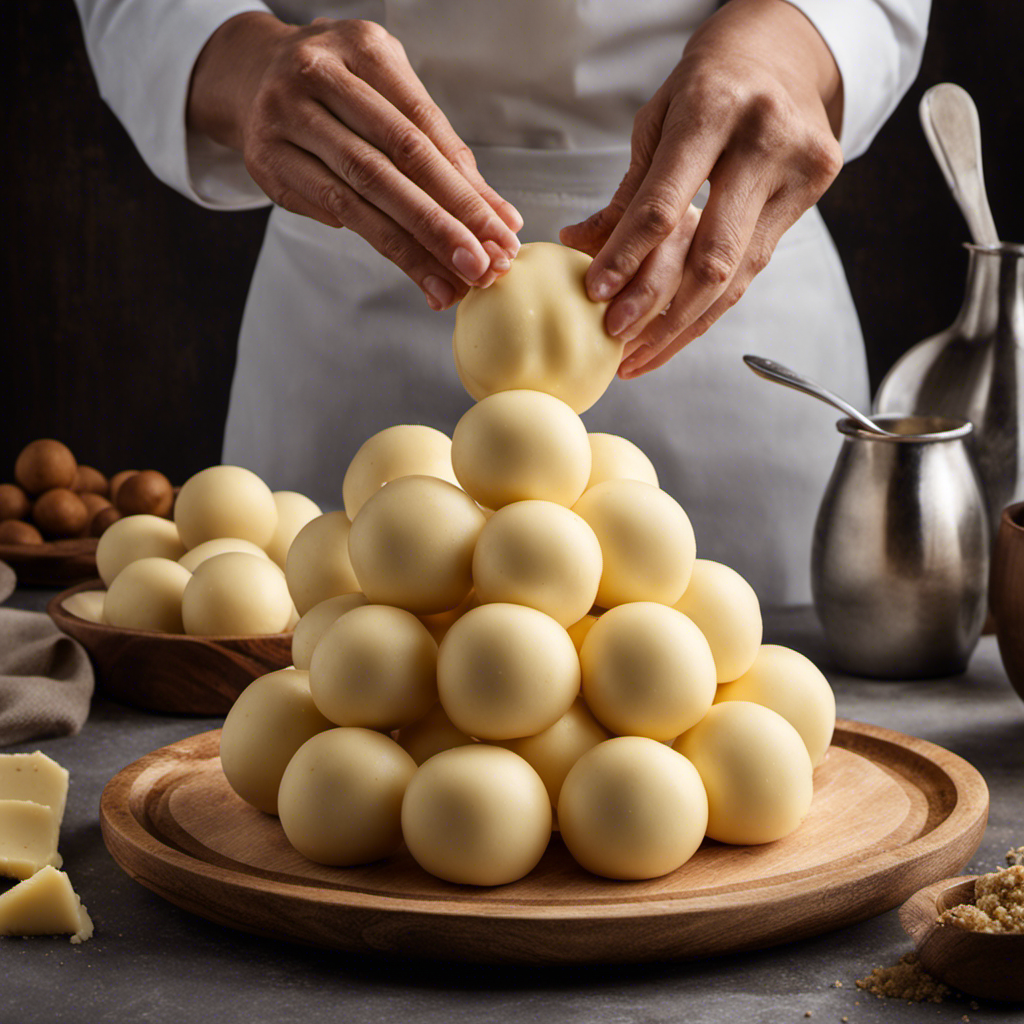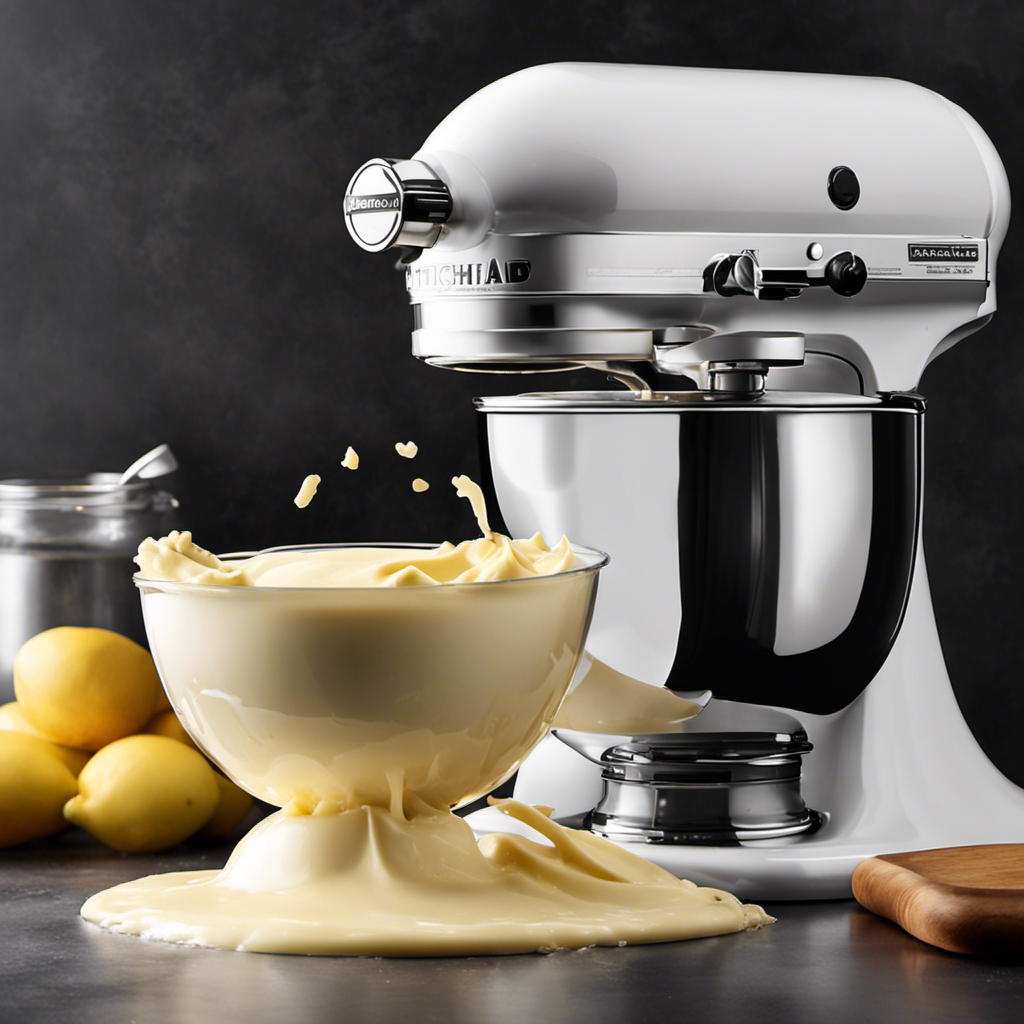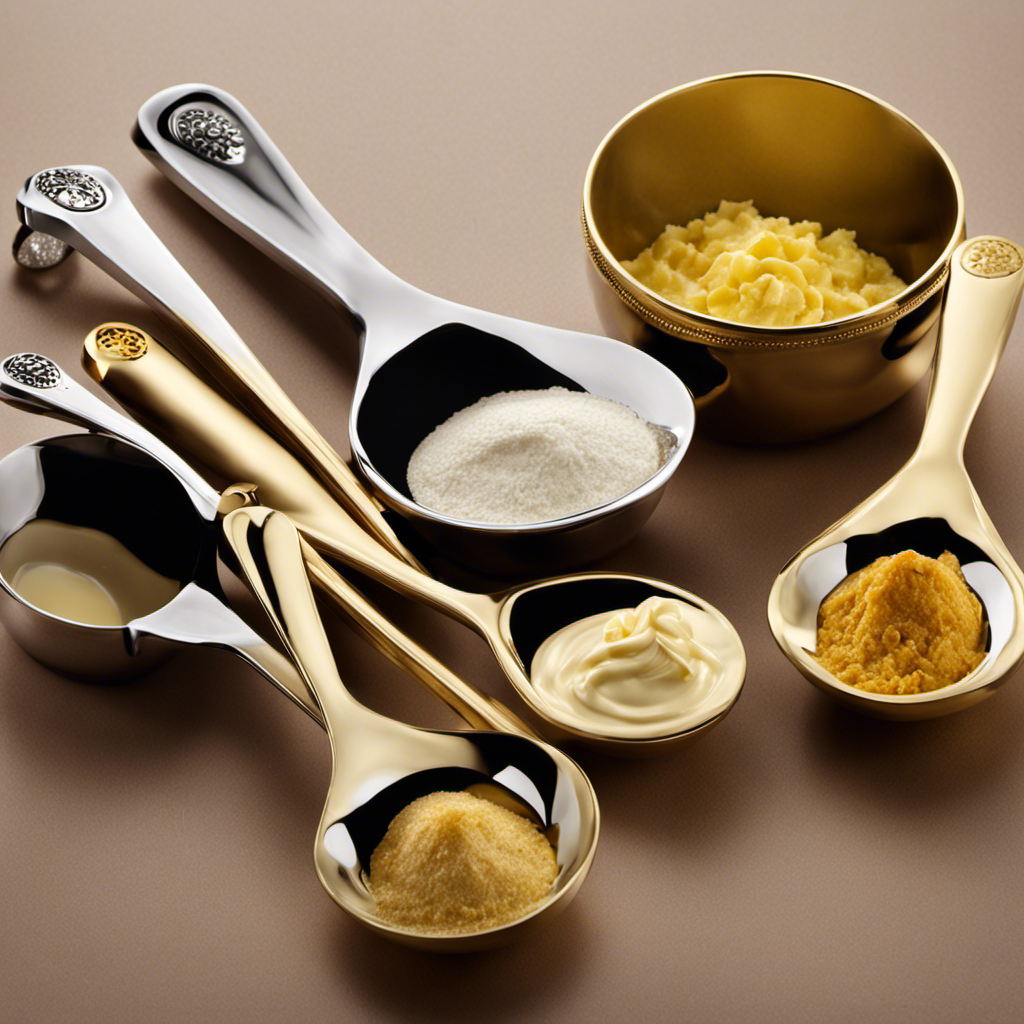I’m here to show you how to make flavored butter that will take your culinary creations to the next level.
Making your own flavored butter is like adding a burst of sunshine to your dishes – it’s simple, fun, and oh-so-delicious.
In this article, I’ll guide you through the process, from choosing the right butter to selecting flavorings and preparing your ingredients.
Get ready to elevate your cooking game with these easy-to-follow steps. Let’s dive in!
Key Takeaways
- Choosing high-quality, unsalted butter is important for making flavored butter.
- Experimenting with different combinations of herbs, spices, and sweet additions allows for customization.
- Popular flavor combinations include garlic and herb, lemon and chili, and honey and cinnamon.
- Softening the butter and incorporating flavorings into it are key steps in making flavored butter.
Choosing the Right Butter
You should choose the right butter for making flavored butter by opting for a high-quality, unsalted variety. When it comes to butter types, it’s important to select one that is of good quality. Look for a brand that uses fresh cream and has a rich, creamy texture. Avoid salted butter as it can overpower the flavors you want to add. Unsalted butter allows you to have full control over the taste of your flavored butter.
Now, let’s talk about the flavoring techniques. Once you have chosen your butter, you can get creative with your flavorings. Some popular options include herbs like basil or rosemary, spices like garlic or cinnamon, and even sweet additions like honey or chocolate. Experiment with different combinations to find your perfect blend of flavors.
Selecting Flavorings for Your Butter
When it comes to adding flavor to butter, there are popular combinations that never disappoint.
From the classic pairing of garlic and herb to the tangy and spicy blend of lemon and chili, these flavor combinations are sure to elevate your dishes.
However, don’t be afraid to step outside the box and experiment with unique flavors like lavender and honey or smoked paprika and maple syrup.
The possibilities are endless, and you might just discover a new favorite flavor combination along the way.
Popular Flavor Combinations
To create popular flavor combinations for your flavored butter, try combining ingredients like garlic and herb, honey and cinnamon, or lemon and dill. These combinations not only add a burst of flavor to your butter, but they also offer a variety of benefits.
Garlic and herb flavored butter is perfect for spreading on bread or using as a savory topping for grilled meats. The combination of honey and cinnamon adds a touch of sweetness to your butter, making it ideal for spreading on pancakes or toast. Lemon and dill flavored butter is refreshing and pairs well with seafood dishes.
Experimenting with different flavors allows you to customize your butter to suit your taste preferences. In the next section, we will explore unique flavor combinations to take your flavored butter to the next level.
Experimenting With Unique Flavors
Experimenting with unique flavors can elevate your flavored butter to new heights, allowing you to create delicious combinations that will surprise and delight your taste buds.
When it comes to flavored butter, the possibilities are endless. Here are three ways to explore savory options and experiment with herbs:
-
Think outside the box: Don’t limit yourself to traditional herbs like basil or thyme. Try experimenting with more unusual herbs like tarragon or lavender for a unique twist.
-
Mix and match: Combine different herbs to create your own signature blend. For example, try mixing rosemary and sage for a fragrant and earthy flavor.
-
Get inspired by cuisines: Take inspiration from different cuisines around the world. Add spices like cumin and coriander for a Middle Eastern flair or chili peppers for a spicy kick.
By experimenting with herbs and exploring savory options, you can create flavored butter that adds a burst of flavor to any dish.
Now, let’s move on to preparing your ingredients.
Preparing Your Ingredients
When it comes to cooking, the key to a successful dish often lies in the ingredients used. That’s why it’s important to carefully select and prepare your ingredients before you start cooking.
In this discussion, we will explore some helpful tips for selecting the best ingredients and ensuring they are properly prepared to enhance the flavors and textures of your dishes.
Ingredient Selection Tips
You can easily enhance the flavor of your butter by selecting high-quality ingredients. When it comes to ingredient pairing, there are a few key tips to keep in mind.
-
Choose complementary flavors: Pair ingredients that naturally go well together, such as herbs and citrus zest, or sweet and savory combinations like honey and garlic. The right pairing can create a harmonious flavor profile in your butter.
-
Experiment with different ingredients: Don’t be afraid to get creative! Try adding spices, dried fruits, or even cheese to your butter for a unique twist. The possibilities are endless, so have fun exploring different flavor combinations.
-
Use flavor infusion techniques: To infuse your butter with maximum flavor, try techniques like steeping herbs in melted butter or blending ingredients together to create a smooth and well-incorporated mixture. These methods ensure that the flavors are evenly distributed throughout the butter.
Proper Ingredient Preparation
To properly prepare your ingredients for making flavored butter, follow these steps:
-
Start by washing and drying any fresh herbs or citrus zest that you plan to use. This is important to remove any dirt or residue and ensure clean flavors.
-
Once your ingredients are clean, measure them out. Finely chop the herbs and measure the desired amount. For citrus zest, use a microplane or zester to grate the peel, being careful to avoid the bitter white pith.
-
There are two ways to infuse the flavors into the butter. You can either add the chopped herbs or citrus zest directly to the softened butter or create a compound butter by gently melting the butter and incorporating the flavors before allowing it to solidify again.
Now that our ingredients are prepared, let’s move on to the next step: softening the butter.
Softening the Butter
Before adding any flavors, make sure your butter is softened to easily incorporate the ingredients. Softening butter is a crucial step in making flavored butter, as it allows for a smooth and creamy consistency. There are several techniques you can use to soften butter quickly and effectively.
-
Room Temperature Method: Simply take the butter out of the refrigerator and let it sit at room temperature for about 30 minutes. This allows the butter to soften naturally without using any heat.
-
Microwave Method: Cut the butter into smaller pieces and place them in a microwave-safe bowl. Heat the butter in short bursts of 10 seconds, checking and stirring in between each burst until the desired softness is achieved.
-
Grating Method: If you need softened butter in a hurry, grate the cold butter using a cheese grater. The increased surface area helps the butter soften faster.
When it comes to alternative butter options, you can also use margarine or plant-based spreads as a substitute. Just make sure to adjust the flavors accordingly to create a delicious and unique flavored butter.
Mixing in the Flavorings
Once the butter has softened, it’s time to mix in the flavorings for a delectable twist. Mixing in the flavorings is where the magic happens, as it allows you to create unique and delicious flavored butters. There are various mixing techniques and flavor infusion methods that can be used to achieve different tastes and textures.
One popular method is to simply mix the softened butter with herbs and spices. This can be done by finely chopping the herbs and mixing them into the butter along with your desired spices. Another technique is to create a compound butter, which involves mixing the softened butter with other ingredients such as garlic, lemon zest, or even cheese.
To give you an idea of the endless possibilities, here is a table showcasing some flavor combinations for flavored butter:
| Flavor Combination | Ingredients |
|---|---|
| Garlic Herb | Garlic, parsley, thyme, rosemary |
| Lemon Pepper | Lemon zest, black pepper |
| Sun-dried Tomato | Sun-dried tomatoes, basil |
| Honey Cinnamon | Honey, cinnamon |
These are just a few examples, but feel free to experiment and create your own unique flavor combinations. The key is to mix the flavorings thoroughly into the softened butter to ensure that the flavors are evenly distributed. So, get creative and enjoy the process of mixing in the flavorings to create a butter that will elevate any dish.
Incorporating Additional Ingredients
When it comes to cooking, I love to push the boundaries and try out unique flavor combinations. It’s exciting to experiment with different ingredients and see how they can transform a dish into something extraordinary.
In this discussion, we’ll explore the world of unique flavor combinations and delve into the art of experimenting with ingredients to create delicious and memorable meals.
Unique Flavor Combinations
To create unique flavor combinations, you can experiment with different herbs and spices in your flavored butter. It’s amazing how a simple addition of herbs or spices can transform regular butter into a mouthwatering treat.
Here are three ideas to get you started on creating your own flavors:
-
Citrus Zest: Add a burst of freshness by incorporating citrus zest into your butter. Whether it’s lemon, orange, or lime, the zesty flavor will brighten up any dish.
-
Savory Herbs: Experiment with savory herbs like rosemary, thyme, or sage to give your butter a robust and earthy taste. These herbs work well with grilled meats or roasted vegetables.
-
Spicy Kick: If you enjoy a little heat, try adding chili flakes or cayenne pepper to your butter. This will give your dishes a fiery kick and add excitement to your meals.
Experimenting With Ingredients
You can get creative and try out different ingredients to discover new and exciting flavor combinations. When it comes to experimenting with herbs and trying different spices, the possibilities are endless.
Adding fresh herbs like rosemary or thyme can bring a fragrant and earthy taste to your flavored butter. Alternatively, you can try using spices such as paprika, cumin, or turmeric to add a hint of warmth and complexity.
Don’t be afraid to mix and match different herbs and spices to find your perfect combination. For a citrusy twist, you can even add a squeeze of lemon or lime juice.
The key is to have fun and let your taste buds guide you as you explore the world of flavor possibilities.
Shaping and Storing Your Flavored Butter
After shaping your flavored butter into a log, it can be stored in the refrigerator for up to a week. This allows the flavors to meld together and intensify, making it perfect for spreading on toast or using in recipes.
Here are three shaping techniques for flavored butter that will not only make it look beautiful, but also make it easier to use:
-
Roll and Wrap: Roll the flavored butter into a log shape using plastic wrap. Twist the ends of the plastic wrap tightly to secure the log shape. This method is great for slicing the butter into rounds.
-
Mold and Shape: Use a small cookie cutter or silicone mold to shape the butter into fun and decorative shapes. This is a great way to add a touch of elegance to your butter when serving it at special occasions.
-
Pipe and Swirl: Fill a piping bag fitted with a star tip with the flavored butter. Pipe the butter onto a parchment-lined baking sheet in swirls or rosettes. This method is perfect for adding a decorative touch to your butter when serving it at parties or events.
By using these shaping techniques, you can elevate the presentation of your flavored butter while still ensuring it stays fresh and delicious for up to a week in the refrigerator.
Using Flavored Butter in Cooking
Now that you know how to shape and store your flavored butter, let’s explore all the delicious ways you can use it in cooking.
One of the simplest ways to enjoy flavored butter is by using it as a spread. Whether it’s on warm bread, toast, or even pancakes, the creamy and flavorful butter adds a burst of taste to every bite.
But why stop there? You can also incorporate flavored butter into desserts for a unique twist. Imagine a rich chocolate cake with a hint of orange-flavored buttercream frosting, or a warm apple pie topped with cinnamon honey butter. The possibilities are endless!
Pairing Flavored Butter With Different Foods
When using different types of bread, consider pairing them with complementary flavors of butter for a delightful taste experience. Flavored butter can elevate any dish, and desserts are no exception. Here are three creative ways to use flavored butter in recipes:
-
Cinnamon Honey Butter: Spread this aromatic butter on warm cinnamon rolls or toast for a sweet and indulgent treat. The combination of cinnamon and honey adds a comforting warmth to any dessert.
-
Lemon Blueberry Butter: Whip up a batch of this tangy butter to add a burst of freshness to your favorite baked goods. It pairs perfectly with muffins, scones, or even pancakes. The zesty lemon and juicy blueberries create a delightful flavor combination.
-
Chocolate Hazelnut Butter: This decadent butter is a dream come true for chocolate lovers. Slather it on croissants or use it to make a rich and creamy frosting for cakes and cupcakes. The combination of chocolate and hazelnut is simply irresistible.
Get creative with flavored butter and take your desserts to the next level.
Serving Suggestions for Flavored Butter
Enhance your dining experience by exploring unique serving suggestions for your favorite flavored butters.
Flavored butter is a versatile condiment that can be used in a variety of creative ways to elevate your dishes.
One delicious serving suggestion is to spread a generous amount of garlic and herb butter on a warm slice of crusty bread. The savory flavors of the butter will melt into the bread, creating a mouthwatering appetizer.
Another creative use for flavored butter is to melt it over grilled vegetables. The creamy texture and rich flavors of the butter will add a delightful twist to your favorite veggies.
Lastly, try using flavored butter as a topping for grilled steak or fish. The butter will melt and create a luscious sauce that complements the meat perfectly.
Get creative with your serving suggestions and discover new ways to enjoy the deliciousness of flavored butter.
Troubleshooting and Tips for Making Flavored Butter
To troubleshoot and improve your process, try using room temperature ingredients when making your favorite flavored butter. This can help prevent issues such as clumping or separation.
Here are some additional tips to help you troubleshoot and create the most delicious flavored butter:
-
Experiment with creative flavor combinations: Don’t be afraid to think outside the box and try unique combinations like honey lavender or chili lime. The possibilities are endless!
-
Adjust the salt levels: If your flavored butter tastes bland, try adding a pinch of salt to enhance the flavors. Remember, a little goes a long way, so start with small amounts and taste as you go.
-
Incorporate fresh herbs: Adding fresh herbs like basil, thyme, or rosemary can elevate the taste of your flavored butter. Chop them finely and mix them in for a burst of freshness.
Frequently Asked Questions
How Long Can Flavored Butter Be Stored in the Refrigerator?
Flavored butter can be stored in the refrigerator for up to two weeks. To ensure long term storage, it is best to use airtight containers or wrap it tightly in plastic wrap.
Can I Use Margarine Instead of Butter for Making Flavored Butter?
Can I use margarine instead of butter for flavored butter? Margarine vs. butter: which is better? Using margarine affects the flavor, as it has a different taste and texture. Butter is creamier and adds richness to the butter.
Can I Freeze Flavored Butter?
Yes, you can freeze flavored butter. It’s a great way to preserve the delicious taste and extend its shelf life. Just make sure to wrap it tightly in plastic wrap or store it in an airtight container to prevent freezer burn.
Can I Use Dried Herbs Instead of Fresh Herbs for Flavoring My Butter?
Using dried herbs for flavored butter vs. using fresh herbs: dried herbs provide a longer shelf life and concentrated flavor, while fresh herbs offer a more vibrant taste. Store flavored butter in an airtight container in the refrigerator for up to two weeks.
Can I Use Flavored Butter for Baking?
I love using flavored butter in my baking! It adds a delicious twist to my recipes. There are many substitutes for flavored butter, like extracts or spices. The benefits are endless – enhanced flavor, moist texture, and a unique touch to your baked goods.
Conclusion
In conclusion, making flavored butter is a simple and creative way to enhance the taste of your dishes. By choosing the right butter and selecting flavorful ingredients, you can create a variety of delicious options.
Did you know that flavored butter can be stored in the refrigerator for up to two weeks? This means you can always have a tasty and versatile ingredient on hand to elevate your cooking.
So why not give it a try and discover the endless possibilities that flavored butter has to offer?










